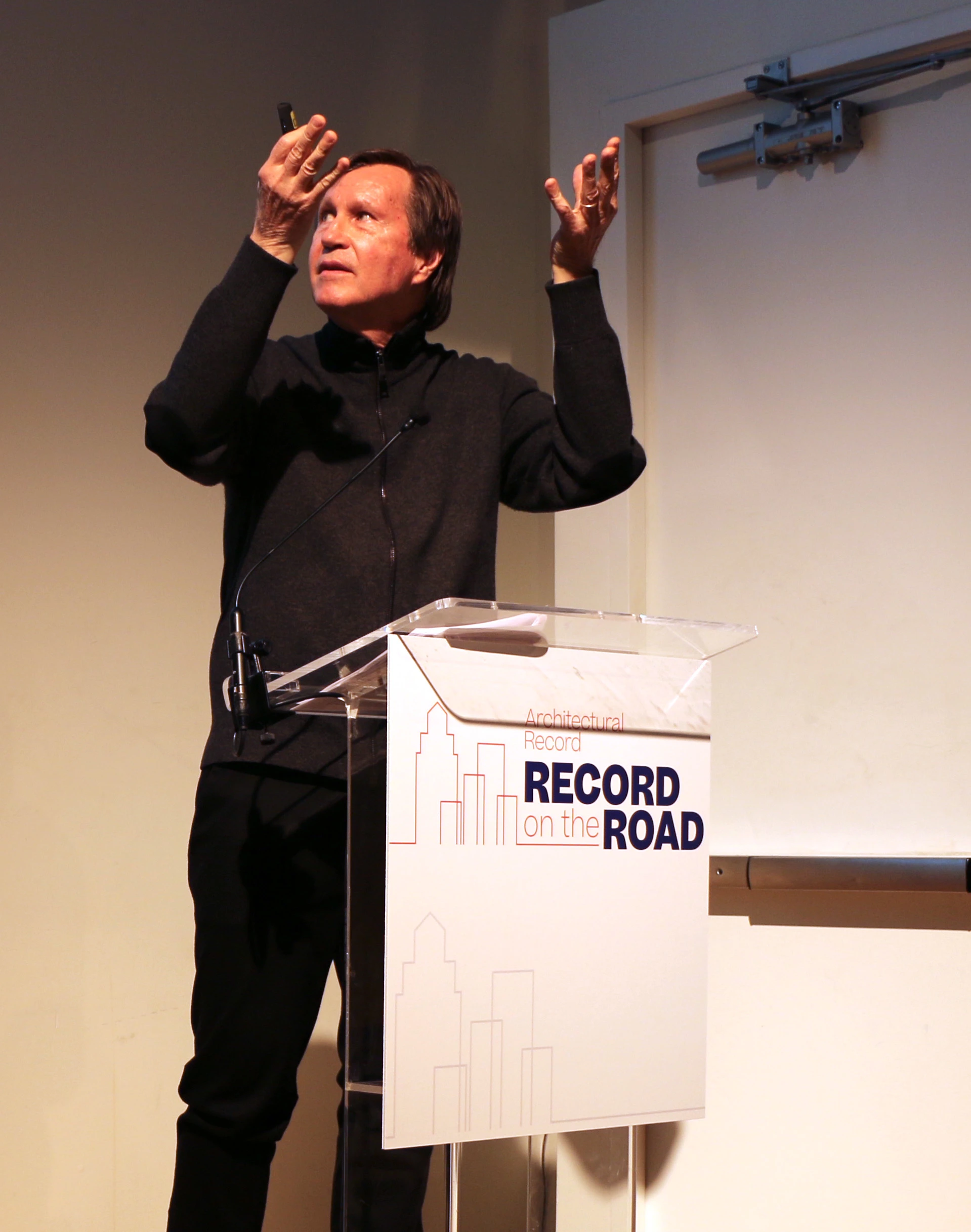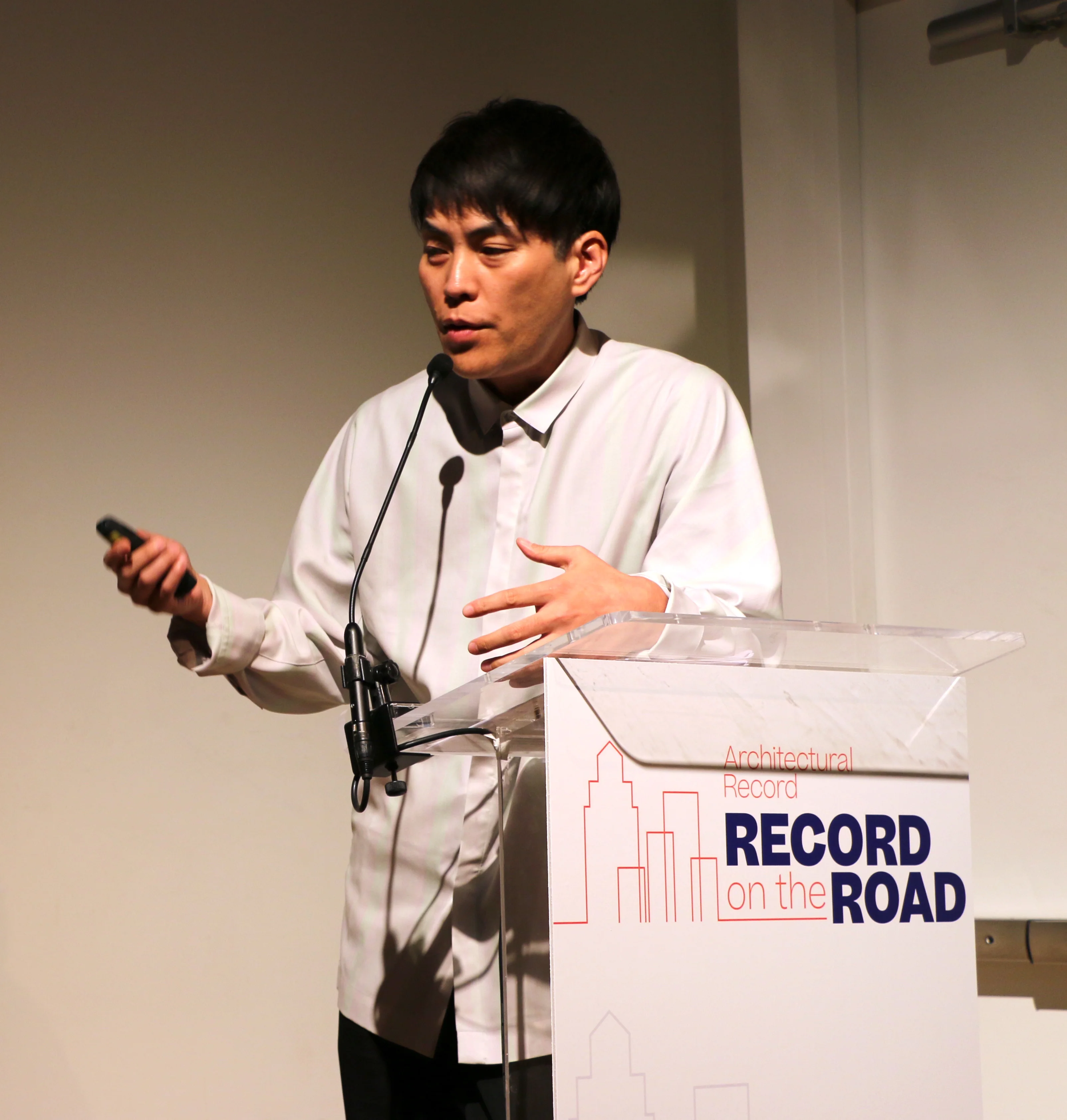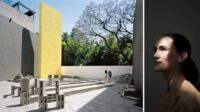On Tuesday, March 21, Architectural Record presented its latest Record on the Road editorial symposium to a packed house at the New Museum on Manhattan’s Lower East Side.
The SANAA-designed museum, the only dedicated contemporary art museum in New York City, was a fitting venue for the sold-out event, which brought together two prominent New York–based architects—Thomas Phifer, founder of Thomas Phifer and Partners, and OMA partner Shohei Shigematsu—to detail in-progress commissions led by their respective firms.
Following these individual presentations was a lively group discussion led by RECORD editor in chief Josephine Minutillo. Joining Phifer and Shigematsu on stage for the conversation were the leaders of three prominent New York museums—Thelma Golden, director and chief curator of the Studio Museum in Harlem, Metropolitan Museum of Art director Max Hollein, and Lisa Phillips, Toby Devan Lewis director of the New Museum—who detailed the transformative efforts underway at each of their respective institutions: a trio of major gallery redesign-reimagining projects at the Met helmed by NADAAA, WHY Architects, and Frida Escobedo; a new Adjaye Associates–designed home for the Studio Museum in Harlem rising on the same 125th Street site as the museum’s previous long-time facility; and a major expansion of the New Museum led by OMA.

Thomas Phifer presenting at Record on the Road.
Photo by Pansy Schulman, Architectural Record
Also joining the talk was Joseph Mizzi, president of Sciame Construction, which has served as builder of myriad high-profile—and often technically complex—cultural projects in New York, including the SANAA-designed New Museum and its forthcoming expansion, the new facility for the Studio Museum in Harlem, and the Perelman Performing Arts Center, scheduled to open in September. In addition to showcasing individual projects, the conversation addressed the changing nature of museums and their missions and programs and how those missions and programs shape architecture. Various themes and topics were addressed, including representation, preservation and adaptive reuse, and new forms of visitor engagement that extend beyond the physical walls of museums.
Following a welcome by RECORD publisher Alex Bachrach, the evening first kicked off with a CE session from Ken Saretsky, general manager of ABC Stone, discussing the company’s involvement with the Tod Williams Billie Tsien Architects–designed Barnes Foundation in Philadelphia. Taking the stage first during the symposium section of the program was Thomas Phifer, who detailed two neighboring projects led by his firm in Poland: The Museum of Modern Art Warsaw and the neighboring TR Warszawa Theatre. Rising under the shadow of what Phifer referred to as “symbol of oppression” in the form of Warsaw’s landmark Stalinist high-rise, the Palace of Culture and Science, the twin projects for two very different but complementary institutions—in the works since 2014—will flank the Forum, a central plaza described by Phifer as a “civic living room” for the residents of Warsaw.
Said Phifer of his experience seeing the museum take shape: “I've been watching the construction workers and learned of the pride that they have in this building. And it began to dawn on me that they understand this building as a voice for them.”
Presenting next was Shigematsu, who detailed three North America museum “extension” projects led by OMA: the completed Pierre Lassonde Pavilion at the Musée National des Beaux-arts du Québec in Quebec City; an ambitious expansion and renovation of New York’s Buffalo AKG Art Museum (formerly the Albright-Knox Art Gallery) that’s set to debut this summer; and the aforementioned expansion of the New Museum, which will see a landmark new building rise next to—and connect with—the institution’s existing home along the Bowery. “For me, the difficult issue nowadays of museum extensions is not about aesthetics or the balance between the existing versus new—it’s that the typology has been evolving to become more like a public space where people gather,” Shigematsu said, noting the challenges of designing buildings for institutions that are “continuously expanding” with collection acquisitions and the demand for community-centric features accelerating at a rapid clip.

Shohei Shigematsu presenting at Record on the Road.
Photo by Pansy Schulman, Architectural Record
As noted by both Golden and Phillips, making way for the new sometimes means doing away with the old, given that growth at both of their respective museums necessitated the demolition of existing structures. When asked if it was possible to save an adjacent 1910 building that was razed to make way for the New Museum’s OMA-designed addition, Phillips stressed that it wasn’t, a conclusion only reached after three years of intensive study.
The building “could have existed on its own as a separate structure but it would have required an awful lot to save it,” she explained.
In the case of the Studio Museum in Harlem, the (once) existing facility, a former commercial building renovated by J. Max Bond Jr. in 1982, had to come down. Golden relayed that when asked if the Harlem community was troubled by the razing of the building, her answer was “almost 100 percent, no—no, they weren’t upset.”
This is partially because “when the community saw the first image that was in the New York Times announcing our new building, David [Adjaye]’s beautiful rendering, what they assumed was that a building like that was going to be downtown … they thought we were moving,” Golden said. “And when I confirmed, ‘no, we're building this right on 125th Street,’ that created a deep sense of pride around what could be possible.”
Golden concluded: “What's so exciting to me about building projects is the future-making component of them. And I think particularly for those of us involved with art, that is a language that we are completely comfortable with, because that’s what artists do—they imagine, and that kind of future imagining is the space of a deep amount of inspiration.”





Post a comment to this article
Report Abusive Comment